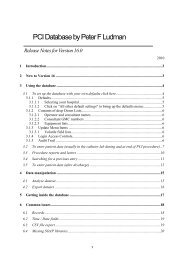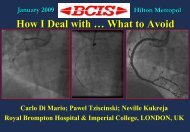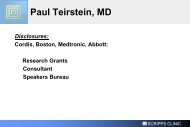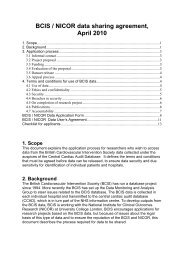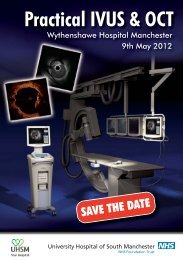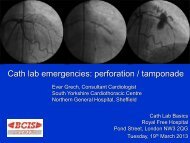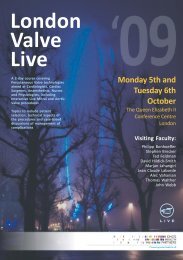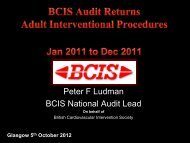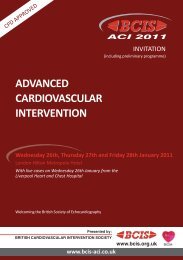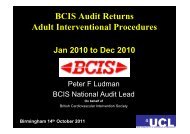Recommendations
ACC/AHA/SCAI PCI Guidelines - British Cardiovascular Intervention ...
ACC/AHA/SCAI PCI Guidelines - British Cardiovascular Intervention ...
- No tags were found...
You also want an ePaper? Increase the reach of your titles
YUMPU automatically turns print PDFs into web optimized ePapers that Google loves.
68<br />
Smith et al. 2005<br />
ACC/AHA/SCAI Practice Guidelines<br />
Table 25. <strong>Recommendations</strong> for Use of GP IIb/IIIa Inhibitors in Patients Undergoing PCI<br />
ACC - www.acc.org<br />
AHA - www.americanheart.org<br />
SCAI - www.scai.org<br />
UA/NSTEMI and<br />
UA/NSTEMI and<br />
Clopidogrel Used Clopidogrel Not Used STEMI Elective PCI<br />
Abciximab, eptifibatide, Abciximab, eptifibatide, or Abciximab Abciximab, eptifibatide,<br />
or tirofiban or tirofiban or tirofiban<br />
Class IIa; LOE: B Class I; LOE: A Class IIa; LOE: B Class IIa; LOE: B<br />
Eptifibatide or tirofiban<br />
Class IIb; LOE: C<br />
LOE indicates level of evidence; PCI, percutaneous coronary intervention; STEMI, ST-elevation myocardial infarction; and UA/NSTEMI, unstable<br />
angina/non–ST-elevation myocardial infarction.<br />
sion (0.5 mcg per kg per min for 20 to 24 h), or aspirin,<br />
heparin, and eptifibatide bolus (135 mcg per kg) and higherdose<br />
infusion (0.75 mcg per kg per min for 20 to 24 h) (198).<br />
The 30-day composite primary end point of death, MI,<br />
unplanned surgical or repeat percutaneous revascularization,<br />
or coronary stent implantation for abrupt closure occurred in<br />
11.4% of placebo-treated patients compared with 9.2% in the<br />
135/0.5-mcg eptifibatide group (P equals 0.063) and 9.9% in<br />
the 135/0.75-mcg eptifibatide group (P equals 0.22) (198).<br />
The frequency of major bleeding events and transfusions was<br />
similar among the 3 groups.<br />
A higher bolus and infusion of eptifibatide was evaluated in<br />
10 948 patients with UA/NSTEMI who were assigned to<br />
treatment with placebo or 1 of 2 doses of eptifibatide: 180<br />
mcg per kg bolus plus 1.3 mcg per kg per min infusion<br />
(180/1.3) or 180 mcg per kg bolus plus 2.0 mcg per kg per<br />
min infusion (180/2.0) (199). Compared with placebo,<br />
patients receiving 180/2.0-mcg eptifibatide had a lower frequency<br />
of 30-day death or MI (15.7% vs 14.2%; P equals<br />
0.042). In patients undergoing early (less than 72 h) coronary<br />
intervention, 30-day composite events occurred less often in<br />
patients receiving 180/2.0-mcg eptifibatide (11.6% and<br />
16.7% in placebo-treated patients; P equals 0.01) (200, 201).<br />
The ESPRIT (Enhanced Suppression of the Platelet IIb/IIIa<br />
Receptor with Integrilin Therapy) trial evaluated the efficacy<br />
and safety of eptifibatide treatment as adjunctive therapy<br />
during nonemergency coronary stent implantation. A total of<br />
2064 patients were enrolled from June 1999 to February<br />
2000 in this multicenter, randomized, double-blind, parallelgroup,<br />
placebo-controlled (crossover-permitted) clinical<br />
trial. A double-bolus regimen of eptifibatide (180 mcg per kg<br />
bolus followed by a 2.0 mcg per kg per min infusion, with a<br />
second 180 mcg per kg bolus given 10 min after the first<br />
bolus) was compared with placebo treatment. The 48-h primary<br />
composite end point of death, MI, urgent target-vessel<br />
revascularization, or bailout treatment with open-label GP<br />
IIb/IIIa inhibitor therapy was reduced 37% from 10.5% to<br />
6.6% (P equals 0.0015). There was a consistent treatment<br />
benefit across all components of the end point and across all<br />
subgroups of patients. At 30 days, the key secondary composite<br />
end point of death, MI, and urgent target-vessel revascularization<br />
was also improved 35% from 10.4% to 6.8% (P<br />
equals 0.0034) (200,201).<br />
6.2.2.3. Tirofiban<br />
Tirofiban is a nonpeptidyl tyrosine derivative that produces a<br />
dose-dependent inhibition of GP IIb/IIIa–mediated platelet<br />
aggregation (720). The clinical effect of tirofiban during<br />
coronary angioplasty was evaluated in the Randomized<br />
Efficacy Study of Tirofiban for Outcomes and Restenosis<br />
(RESTORE) trial, a double-blind, placebo-controlled trial of<br />
2139 patients with UA or acute MI defined by CK measured<br />
at the end of 36 h or at the time of discharge (715). Patients<br />
were randomly assigned to aspirin, heparin, and a tirofiban<br />
bolus (10 mcg per kg over 3 min) plus infusion (0.15 mcg per<br />
kg per minute), or to aspirin, heparin, and a placebo bolus<br />
plus infusion for 36 h. The primary end point of the trial was<br />
the occurrence of major events at 30-day, including death<br />
due to any cause, MI, coronary bypass surgery due to angioplasty<br />
failure or recurrent ischemia, repeat target-vessel<br />
angioplasty for recurrent ischemia, or insertion of a stent due<br />
to threatened abrupt closure (715). The rate of primary 30-<br />
day end point was reduced from 12.2% in the placebo group<br />
to 10.3% in the tirofiban group (P equals 0.160). Patients<br />
treated with tirofiban had a 38% relative reduction in the<br />
composite end point at 48 h (P less than 0.005) and a 27%<br />
relative reduction at 7 days (P equals 0.022). The incidence<br />
of major bleeding was similar in the 2 groups with the TIMI<br />
criteria (2.4% in tirofiban-treated patients and 2.1% in placebo-treated<br />
patients; P equals 0.662) (715), although major<br />
bleeding tended to be higher in tirofiban-treated patients<br />
(5.3% vs 3.7% in placebo-treated patients; P equals 0.096).<br />
Thrombocytopenia was similar in both groups (0.9% for the<br />
placebo group vs 1.1% for the tirofiban group; P equals<br />
0.709) (721). A larger clinical benefit with tirofiban was seen<br />
in patients with UA undergoing coronary angioplasty in the<br />
PRISM-PLUS study, a randomized trial of 1570 patients<br />
with UA or non–Q-wave MI assigned to 48- to 108-h treatment<br />
with heparin plus tirofiban or heparin alone (722).<br />
Coronary angioplasty was performed in 30.5% of patients<br />
between 49 to 96 h after randomization (722). The composite<br />
end point of death, MI, or refractory ischemia was<br />
reduced significantly in the heparin plus tirofiban group<br />
compared with the heparin alone group (10.0% vs 15.7%; P<br />
less than 0.01) (722).



